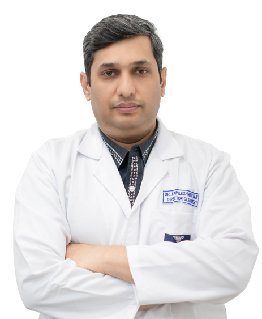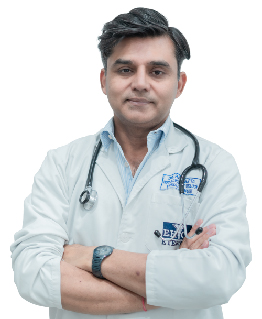For OPD:
+91-9549158888Robotic Surgery aids surgeons in performing various complex surgical procedures with better accuracy, adaptability, and control than conventional techniques. This type of surgery typically involves small incisions, resulting in minimally invasive surgery. However, robotic techniques can also be used in performing open surgeries.
Commonly referred to as Robot-Assisted Surgery, a typical robotic surgical system includes a camera arm and mechanical arms that are linked to surgical instruments. The surgeon operates from a control center or console positioned near the operating table, utilizing a magnified, high-definition 3D visualization of the surgical area. The control of these robotic arms is with the surgeon performing the surgery.
The Eternal Hospital has been equipped with advanced robotic surgical equipment, namely the da Vinci Xi® Surgical System. This surgical system is equipped with four fully functional robotic arms—dedicated for the endoscope, bipolar and monopolar instruments, and precision graspers. This multi-arm setup enhances surgical accuracy, stability, and efficiency, giving the surgeon superior control throughout the procedure.
Key Features of Da Vinci Xi Assisted Robotic Surgery at Eternal Hospital
Eternal Hospital is equipped with the multiport robotic surgical system, Da Vinci Xi, the latest and most advanced robotic technology trusted and widely adopted by experts. Following are the key features of this high-end technology:
- Built for multi-specialty use with wide anatomical reach
- Flexible system architecture enhances access to complex areas
- Fourth-generation modular design with an adaptable configuration for different procedures
- Highly magnified 3DHD imaging for catching crystal-clear anatomical details
- Integrated Firefly® fluorescence imaging gives real-time visualization of vessels, bile ducts, and tissue perfusion
- Wristed instruments that bend and rotate more than the human hand
- Tremor filtration and intuitive motion technology ensure natural, steady, ultra-precise surgical movements
- Boom-mounted architecture support optimal access & reach
- Integrated table motion for continuous surgical flow
- Guided setup & user-friendly interface
- Visual and audible cues simplify system setup
- Easy-to-learn interface reduces operating room preparation time
Components of Da Vinci Xi, the Latest And Most Advanced Robotic Technology
Robotic surgery is not intended to substitute for the surgeon’s role; rather, it serves as one of several techniques employed during procedures to assist the surgeon for better surgical outcomes. Studies indicate that the results of robotic surgery are comparable to those achieved with laparoscopic surgery. This technology is often utilized by healthcare professionals for minimally invasive operations.
There are 3 main components of Da Vinci Xi:
1. Patient Cart: It holds the small sophisticated instruments with more precision than human hands.
Key features of the patient cart:
- Boom: It is an adjustable support structure that promotes flexibility in positioning patient cart arms over the surgical workspace.
- Universal arms: The arms allow assignment and reconfiguration of the endoscope and instruments to desired ports during a surgical procedure, thereby enabling better tissue access and visualization. The patient cart of the da Vinci Xi Surgical System has 4 arms:
- Helm Touchpad: It enables non-sterile OR staff to select Patient Cart settings and adjust the boom height/position, improving system setup efficiency.
- Vision Cart: It is the brain of the system; all the connections are here and it provides the Surgical HD view for bedside assistance
Key features of the vision cart:
- Touchscreen Monitor: It provides high-quality view of surgical image and allows non-sterile OR staff to adjust vision settings and troubleshoot faults
- ERBE VIO® Electrosurgical Generator: This unit is integrated with the system; this electrosurgical unit (ESU) indicates location of installed energy instruments and displays energy effect settings at the Surgeon Console, increasing surgeon autonomy
- Endoscope Controller: It provides a high-intensity light source to illuminate the surgical site and houses electronics that promote efficient endoscope setup
Surgeon console
It allows the surgeon to operate all of the instruments easily and move the camera.
Key features of the Surgeon Console
- 3D Viewer: For enhanced vision of anatomy
- Hand Controls (Masters): For intuitive motion translated into precise, fine, tremor-filtered movements at instrument tips
- Ergonomic design: To increases ergonomic comfort for surgeon during surgery
Clinical Specialities Utilising Robotic Surgery For Better Outcomes at Eternal Hospital
- Cardiothoracic Surgeries
- Urology
- Gynaecology
- General & GI surgery
- Oncology
Types of Surgeries Accomplished with Advanced Robotic Techniques
- CTVS (Cardiothoracic & Vascular Surgery): It is a surgical specialty that involves the surgical procedures of the heart, lungs, chest, and major blood vessels.
- Lung Resection: It is a surgical procedure that involves the partial or complete removal of a diseased or damaged lung. It is generally done to treat cancer, infection, or other conditions.
- Thymectomy: It involves the surgical removal of the thymus gland. It is done to treat conditions like myasthenia gravis (an autoimmune disorder) and thymoma (a type of tumor).
- Esophagectomy: Complete or partial removal of a diseased or damaged esophagus.
- MICS (Minimally Invasive Cardiac Surgery): It is a type of heart surgery that involves small incisions. Unlike conventional heart surgery, the breastbone is preserved in this procedure, making it a less invasive alternative to traditional open-heart surgery
Urological Surgery: It involves the treatment of disorders of the urinary tract and the male reproductive system surgically.
- Pyeloplasty: It is a surgical treatment used to treat ureteropelvic junction (UPJ) obstruction, which is an obstruction where the ureter and kidney's collecting region (renal pelvis) meet.
- Simple & Radical Nephrectomy: A radical nephrectomy, which is usually carried out for kidney cancer, removes the kidney alongside the surrounding fat, adrenal gland, and surrounding lymph nodes. A simple nephrectomy involves the removal of a single kidney for benign disorders.
- Partial Nephrectomy: It is a surgical procedure for the removal of only a part of the kidney.
- Prostatectomy: It involves the complete or partial surgical removal of the prostate gland. It is mainly used to treat prostate cancer or benign prostatic hyperplasia
- Adrenalectomy: It involves the surgical removal of one or both the adrenal glands.
- Ureteric Reimplantation: In order to repair vesicoureteral reflux (VUR), ureteral reimplantation is done, which is a surgical operation that fixes the connection between the ureter and the bladder.
- Radical Cystectomy: It is a complex surgery that is done to remove the bladder and surrounding pelvic lymph nodes. It is opted to remove aggressive or muscle-invasive bladder cancer.
- Vesicovaginal Fistula Repair: It is a surgical procedure performed to close the abnormal connection between the bladder and vagina. It can be done transvaginally, transabdominally, and laparoscopically.
Abdominal & Gastrointestinal Surgery: These are the surgical procedures that are done to treat the disorders of the gastrointestinal tract.
- Cholecystectomy: It is the surgical removal of the gallbladder.
- Choledochal Cystectomy: It is a surgical procedure for the removal of a choledochal cyst, a rare congenital bile duct disorder.
- All kinds of hernia surgery: These are surgical treatments for managing all types of hernia.
- Bariatric Surgery: It is a weight loss or metabolic surgical procedure.
- Whipple’s (Pancreatic Surgery): It is a surgical procedure that involves the removal of a part of the pancreas and some more structures.
- Low Anterior Resection: Surgical removal of lower part of rectum
- Splenectomy: Surgical removal of spleen
- Liver Surgery (HPB): It involves surgical procedures of the liver, pancreas, gallbladder, and bile ducts.
Gynecological Surgery: Surgical procedures related to the female reproductive system.
- Hysterectomy: Surgical removal of the uterus.
- Myomectomy: Removal of fibroids while preserving the uterus.
- Ovarian Cystectomy: Surgical removal of cysts from the ovary.
- Radical Hysterectomy: Removal of the uterus along with surrounding tissues for cancer treatment.
- Sacrocolpopexy: Surgical repair of pelvic organ prolapse using mesh support.
- Oophorectomy: Surgical removal of one or both ovaries.
- Uterine Prolapse: A condition where the uterus descends into the vaginal canal.
Benefits of Robotic Surgery
The following are the advantages of Robotic Surgery over conventional ones:
- Faster Recovery Period
- Less Pain & Discomfort
- Reduced Risk of Infection
- Minimal Blood Loss
- Smaller Incision / Minimal Scarring
- Easier Removal of Lymph Nodes (Cancerous Tissue)
- Lower conversion rate to open surgery
- Shorter Hospital Stay
- Greater Precision
FAQs
Q1: Does Robotic Surgery mitigate the likelihood of complications ?
A: Indeed, it does. It decreases the chances of infections, minimizes blood loss, and reduces surgical errors, improving surgical accuracy.
Q2: Is Robotic Surgery more costly ?
A: While it may incur slightly higher expenses compared to traditional surgery, the quicker recovery time and lower risk of complications often help offset these costs.
Q3: Will my hospital stay be extended ?
A: No. Generally, Robotic Surgery leads to a hospital stay that is shorter by several days.
Q4: Can older patients have Robotic Surgery ?
A: Yes, this is possible depending on their health status. Many older individuals experience advantages from quicker recovery and less physical stress.
Q5: How can I determine my eligibility for Robotic Surgery ?
A: Your surgeon will evaluate your diagnosis, medical history, and overall health to assess whether you are a suitable candidate.

.jpg)

